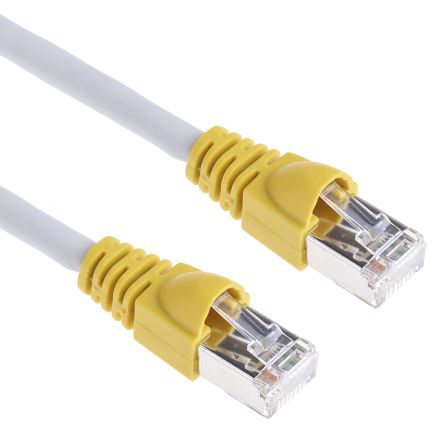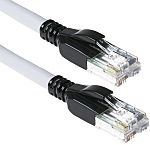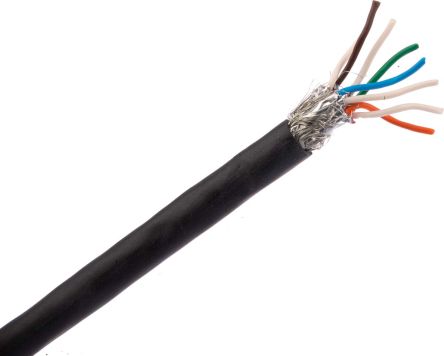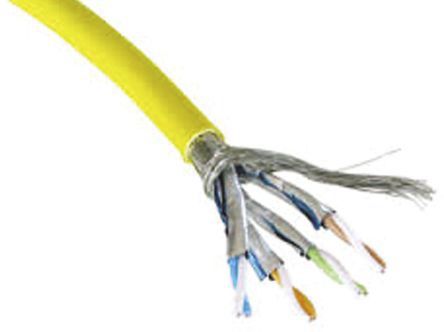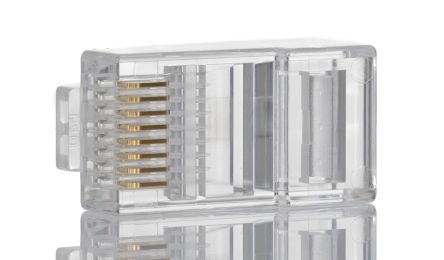
|
What is Cat 7 cable?
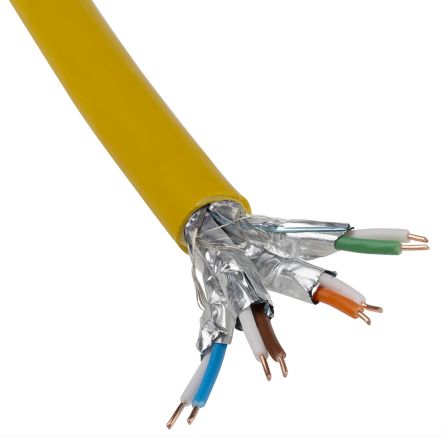
Category 7 cable, more commonly known as a Cat7 or Cat-7 cable, is a type of high-end data transfer patch cable used in delivering the core infrastructure of wired Gigabit Ethernet setups.
It’s a shielded twisted pair cable, used principally in achieving high-speed Ethernet connections at data transfer rates of 1 Gbps or higher between directly linked servers, switches and computer networks.
Today, a highly diverse range of commercial and industrial sectors are showing increased demand for faster internet and data transfer speeds - a modern reflection of the fact that we’re continually finding ways to capitalise on the hyper-efficient capabilities of our cutting edge technology. Especially as we move ever closer to a true ‘Internet of Things’ era, where almost any device you can imagine is able to record and transmit potentially valuable user data in real time, it’s becoming more and more important to stay ahead of an ever-steepening tech curve.
One way in which many users can aim to do just that is to buy Cat7-rated network communication cable when putting together a high-speed internet set up in the workplace or at home. As part of a coherent and comprehensive Ethernet delivery infrastructure, Category 7 cabling represents a valuable step along the path towards optimal speed and efficiency in our wired online experience.
Cat7 cable specifications
Category 7 Ethernet cable specs are defined in the ISO/IEC 11801:2002 (Information technology - Generic cabling for customer premises). This specification is also known as the Class F standard, which is why Cat7 cable is sometimes referred to as an ISO Class F cable. This Cat7 Ethernet cable specification dictates that the wired connection must be:
-
Capable of delivering certain data transfer rates reliably over a defined range of distances
-
Built to to meet stringent criteria around crosstalk and system noise blocking
-
Able to cope with a range of potentially problematic environmental hazards as it delivers these speeds
-
Be guaranteed for a minimum lifespan in continual operation
In the following sections, we’ll look at each of these specifications in more detail.
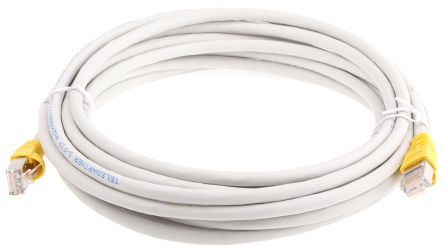
Cat7 cable speed
Cat7 was designed to support 10 Gbps Ethernet, although laboratory tests have successfully shown its ability to far exceed this, transmitting up to 40 Gbps at 50 meters and even 100 Gbps at 15 meters - however, precise setups of compatible hardware will likely be needed to achieve these speeds in practice.
To achieve proper Cat7 Ethernet cable speeds specification, cabling runs must be able to support frequencies (bandwidth) of up to 600 MHz over 100m of copper wire. In terms of raw performance versus earlier revisions, this is theoretically 6 times greater than Cat5e (100 MHz), and 2.4 times greater than Cat6 (250 MHz), but we’ll take a slightly deeper dive into the exact differences between all these popular standards in a moment.
Cat7 cable standards
Cat7 cabling standards were ratified in 2002 to allow 10 Gigabit Ethernet over 100 m of copper cabling. Category 7 wire features four individually shielded twisted copper pairs, as well as an overall cable shield - this helps it to meet the strict criteria covering signal loss over distance, and ensures Cat7 cable is better designed to protect against potential degradation caused by issues such as crosstalk and EMI.
While Cat7 standards differ from earlier revisions such as Cat5 (Class D) and Cat6 (Class E), Category 7 (Class F) is intended to be backwards compatible with systems using either of those previous standards.
Cat 7 cable vs other Ethernet types
What is the difference between Cat6 and Cat7 cable?
The Cat 7 cable is similar in physical makeup to the previous Cat6 cable. Both versions use the same twisted and sheathed four-pair cable design as each other, capable of delivering transmission frequencies (bandwidth) of up to 600 MHz, and therefore both support 10 Gbps Ethernet signals over distances of up to 100m.
One additional strength of Cat7 cable over Cat6 is that the newer variant is better shielded against crosstalk and EMI, having been double-shielded (both individual wire twists and the cable as a whole) to meet more stringent specifications in this regard. This is the only out-of-the-box physical difference between most Cat6 and Cat7 cables - while double-shielded designs are now available with Cat6 and even earlier revisions of Ethernet grade wire, it’s part of the core design for Cat7 versions.
The criteria for performance lifespan of Cat7 cable are also tougher. However, in terms of Cat6 cable vs Cat7, it would be misleading to claim that either was ‘better’ per se. As with so many of these sorts of products, it’s all about picking the right one for achieving what you want it to do, under the conditions you need it to do it in, and at the most cost-effective price for meeting those needs. You can find more in depth information about Cat6 cable in our detailed Cat6 Cable Guide.
What is the difference between Cat5 and Cat7 cable?
As noted above, the jump in potential bandwidth performance between Cat5 and Cat7 Ethernet cable is stated as being in the region of around 6x improvement. This will, of course, depend to a large extent on other factors, particularly for many home users still connecting via increasingly cost-effective Cat5 cabling in their Ethernet/LAN setups due in part to its easy installation and routing.
Key considerations here will generally include the capabilities of individual hardware components elsewhere in the system, and the rated speeds you have access to through your Internet Service Provider.
What is the difference between Cat7 and Cat8 cable?
Cat8 cable was only very recently ratified as a standalone revision, and a noteworthy aspect of the Category 8 standard (under ANSI/TIA 568-C.2-1) is that it’s defined up to 2000 MHz - but only for distances up to around 30m, depending on the specific patch cords used.
In terms of Cat7 vs Cat8 networking performance, the latter is now available on the open market, but buyers should bear in mind that it’s currently intended almost exclusively for use in smaller footprint data centres (where there’s very little distance between servers and switches).
The newest revision may well become a viable option for more general use in due course, but currently, it’s not recommended for most scenarios in which a standard Cat7 version would be expected to perform well.
Types of Cat7 cable
Cat7a cable
The Cat7a specification refers to ‘Category 7 augmented’, or Class F Augmented products. This was introduced by ISO 11801 Edition 2 Amendment 2 (2010), and is defined at frequencies up to 1000 MHz.
Category 7a cable was likely originally introduced as a future-proofing step for the anticipated wider uptake of a 40 Gbps Ethernet standard - however, in 2016 a new ratification meant that this responsibility was effectively handed over to Cat8 cables specified to 2000 MHz. As a result, cable Cat7a as a standalone revision isn’t officially supported by very much equipment to run at significantly faster speeds than Cat7 versions, although speed boosts may be possible in certain applications.
Cat7a Ethernet cable is generally slightly thicker, due to additional shielding intended to boost it towards delivering 1000 MHz speeds. Even so, Cat7a is not technically recognised as a wholly separate revision by most standards today, most notably by the US Telecommunications Industry Association (TIA).
Rather, it’s generally considered alongside Cat7 for performing at similar speeds and distances in most day-to-day applications and environments. Either standard would be seen as a suitable option for demanding use scenarios, such as high-performance data centre applications.
Cat7 RJ45 cable
Most Category 7 Ethernet cables you can buy prepackaged in high street consumer stores will already be terminated with an RJ45 jack at each end for immediate plug-and-play use. This connector type is standard to almost all Ethernet connectivity setups, and will certainly be the plug required by the cable sockets on any standard home router or LAN switch.
When bulk buying Ethernet cable, though, with Cat7 RJ45 connectors installed. In this case, they’ll need to be bought and wired in as separate components once the networking cable has been cut to the desired run length and routed appropriately. In this scenario, two wiring schemes (T568A and T568B) are used to terminate the ends of the twisted copper pairs found inside the jacketing of a Cat7 cable onto the RJ45 connector interface.
What does UTP, FTP, SFTP, STP and SSTP mean?
Whether you’re assessing Cat7a cable prices for a potential upgrade, or looking to buy Cat7 bulk network cable for a major office overhaul, you’ll often see acronyms such as UTP, FTP and SFTP mentioned in manufacturer and supplier product listings for Ethernet wiring.
These prefixes relate to the various configurations used for the wire shielding inside the body of the cable, and can potentially affect anything from cable weight and flexibility to cost-effectiveness and performance.
Below is a brief overview of these common acronyms and what each one means.
UTP Cat7 cable
Cat7(a) UTP cable denotes an Unshielded Twisted Pair design. In this configuration, the four pairs of twisted copper wires that make up a Cat7 Ethernet cable are sheathed only by their own interior jacketing and that of the external cable. In other words, UTP cable comes without any additional shielding placed between the twisted wire pairs and the outside sleeving of the cable.
UTP Cat7 cable is usually the most cost-effective version of Cat7 and Cat7a Ethernet Cable, with solid enough protection against EMI and signal attenuation to meet the baseline requirements for this standard.
F/UTP Cat7 cable
As with the UTP design highlighted above, Cat7(a) F/UTP cable has no additional shielding around each of the twisted wire pairs themselves, but beneath the exterior jacketing of the cable there is a single foil screen encasing the four pairs collectively (hence the Foiled/Unshielded Twisted Pair acronym).
This is considered a moderate level of additional shielding above the baseline requirement for Category 7 and helps protect against signal loss to a slightly greater extent than UTP versions.
STP Cat7 cable and FTP Cat7 cable
Where you see Ethernet cable labelled as either Cat7(a) STP or FTP, these acronyms stand for Shielded Twisted Pair or Foiled Twisted Pair respectively, and they essentially mean the same thing. Going one step further than F/UTP above, both STP and FTP denote that the cable features an additional layer of protective foil screening wrapped around each individual pair of twisted wires inside.
Again, this is a further step closer to optimal protection than the version above.
SFTP Cat7 cable and SSTP Cat7 cable
The most comprehensive level of additional signal protection for Category 7(a) Ethernet cable is typically provided by products marked SFTP (Shielded Foiled Twisted Pair) or SSTP (Shielded Screened Twisted Pair). Following the same pattern as previous entries, the Cat7(a) SFTP or SSTP designation combines both a foil shield/screen between the outer cable jacketing and the inner wires and an additional wrapping around each twisted pair individually.
What is a Cat7 cable used for?
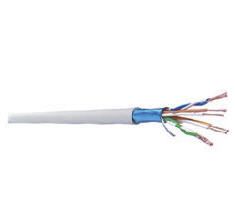
Cat7 and Cat7a 10 Gbps Ethernet cabling is widely used across a number of industries demanding high performance networking and data transfer infrastructure. It’s also quickly becoming very popular with enthusiast home users looking to get the optimal performance out of their own systems and networks.
Some very common examples of Cat7(a) cable being relied on in daily use might include any of the following:
Cat7 Ethernet cables
Category 7 Ethernet cables (also referred to as Cat7 LAN cables in everyday use) are used to form the connective tissue between modems, hubs and individual computers on networks of all shapes and sizes. These can range from sprawling data centres and server environments, through to individual home setups where enthusiasts seeking higher speeds and lower latencies turn to Cat7 cable for gaming, streaming and up/download performance boosts.
Commercial and industrial uses for Cat7 cable
Cat7 cables were originally developed for use in larger-scale industrial Ethernet networks - and, as such, they’re designed not only to provide high speeds and bandwidth capabilities, but also to withstand a broad range of environmental and mechanical hazards.
This can include anything from temperature extremes and UV/moisture exposure, to direct contact with a wide range of solvents, oils and chemicals, making Cat7 wire an equally ideal choice for robust outdoor applications such as railway cables.
Domestic uses for Cat7 cable
In addition to enthusiast gaming setups, Cat7 cables have become increasingly popular with home users across a wide range of domestic LAN cable networks and connectivity setups in recent years.
While it’s certainly true that very few typical home hardware setups will support anything like the sorts of data transfer speeds and bandwidths that Cat7(a) Ethernet cabling can, using the highest revision wire you can will still offer potential performance boosts in many basic router-to-device networking scenarios.
Additionally, many people first bought into Ethernet connectivity fairly early on in the home hub era (around the Cat5 cable revision or earlier), and naturally look to the latest versions when needing to replace or upgrade older cables. Those planning to wire a smart home today, for example, might typically gravitate towards Cat7 and Cat7a as a future-proofing measure, anticipating the continued acceleration of home hardware and connection speeds over the coming years.
One thing to bear in mind when upgrading or replacing a home network cabling setup is that Cat7 and Cat7a versions tend to be considerably thicker, stiffer and heavier than their Cat5 predecessors, and this may affect on your ability to route the cables neatly in places where space is at a premium or very precise bends are required.
Summary
When planning or shopping for the right type of Ethernet networking cables for your needs, it’s important to remember that there are numerous grades, distinctions and categorisations even within a particular version/revision of Ethernet cabling.
For Cat7(a) cables, you can optimally support current and future network speed potential by selecting products that benefit from more advanced additional shielding, or by designing the network such that distances are reduced and signal attenuation is minimised. In many applications, these sorts or variables can often give dramatically different results, even for two setups using functionally identical Category 7 or Cat7a cables.
Product spotlights
Browse our best selling Cat7 cable products:
